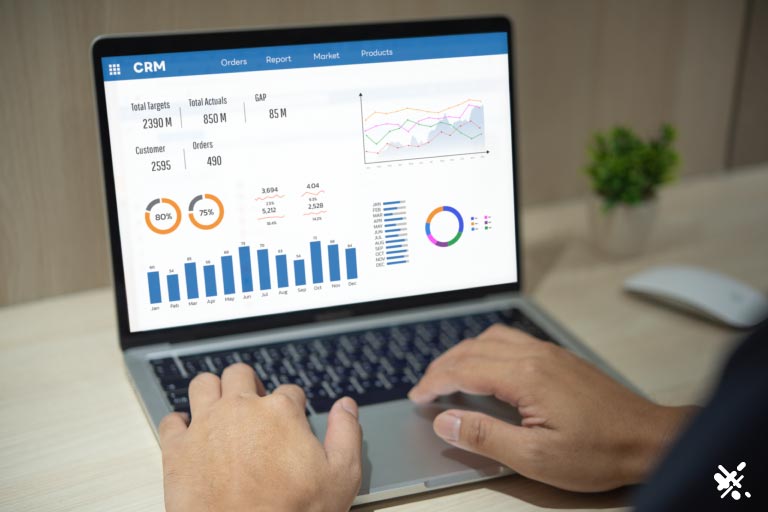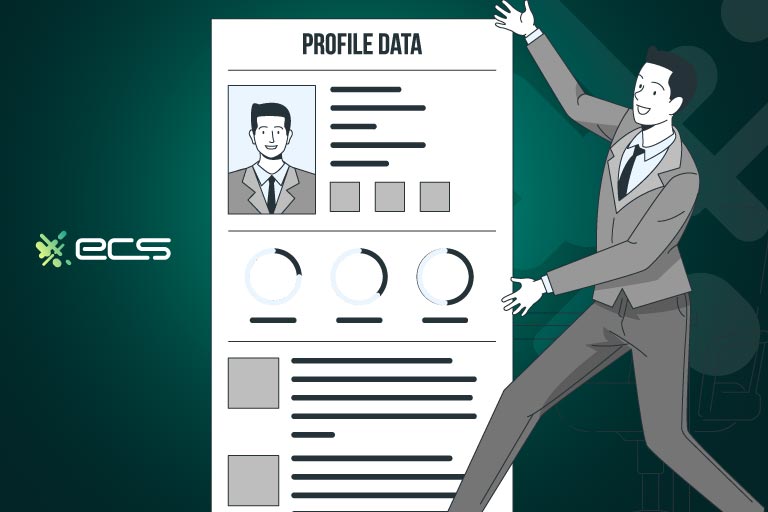Customer data refers to personal, financial, behavioral, and demographic information about your customers. You might be wondering why collecting customer data is important. Customer data capture is important for facilitating recurring payments. It’s also important for guiding marketing strategies—both on a personal and market-wide level.
What is Personal Data, And Why Collect It?
Personal data is a broad term encompassing many different pieces of information. Name, address, social security number, and favorite ice cream flavor are all personal data. Consumer data collection typically involves name and contact information—address, email, and phone number.
Other pieces of information might be relevant, but that will vary from business to business. For instance, an ice cream chain may be interested in knowing a consumer’s favorite flavor of ice cream, but there is no reason they need a social security number. And while a bank needs a social security number to open a checking or savings account, they don’t need to know their favorite ice cream flavors.
What is Financial Data, And Why Collect It?
Customer financial data is often lumped together with personal data, but we’ll separate it for the sake of elaboration. Financial data refers to things like payment information. This might include credit or debit card numbers or bank account and routing numbers for customers using ACH payments.
Recurring products or services require a business to collect financial data. That’s because automated recurring payments are the most sensible method of collecting payments. And to automate the payments, the business has to gather information from the customer: a credit card number, debit card number, or bank account and routing number.

What is Behavioral Data, And Why Collect It?
Behavioral data is information about how customers behave. When do they shop? What do they typically purchase? How much do they spend? Do they prefer face-to-face interactions or online orders? These pieces of information can help a business make informed decisions and improve customer experience.
Customer expectations now include personalized recommendations based on collecting customer insights. Shoppers take it for granted that Amazon sends product recommendations based on purchase or browsing history. They expect to receive coupons in the mail for items that they typically purchase.
What is Demographic Data, And Why Collect It?
Demographics are groups of people. While capturing individual data points can help market to every consumer in “their language,” individual data points don’t always translate to market-wide insights.
For that, you need consumer insights drawn from a larger pool. Demographic data can help make bigger business decisions, such as opening a new location, marketing campaigns, and what products or services to offer.
The shopping habits of one person cannot tell you if you should remove an entire product line or open a second location. But demographic data from hundreds, thousands, or millions of individual consumers yields insights.
If nobody is buying a certain product, pull it. If 50% of your shoppers are from a particular different zip code, it might be a good location for another location.
Qualitative and Quantitative Data
Quantitative data refers to countable and measurable data points. How much does the average customer spend? What are the hottest-selling items? What days of the week are the busiest? You can answer these questions by looking at hard numbers from sales and inventory.
Quantitative data is a little bit more…artistic. This is descriptive, language-based data often grounded in interpretation and emotion. How do customers feel about our business? What do they think about our logo? What keeps them shopping with us instead of turning to competitors?
Numbers cannot necessarily answer these questions. You must hear from customers via conversations, surveys, or focus groups.
Both data sets are necessary for creating solid customer service and experience. Even large corporations with the most cutting-edge analytics tools realize this. That’s why they’re practically begging customers to share their opinions at the bottom of every receipt. That’s why they invest so much time responding to comments on review sites and social media platforms.
Methods of data collection that only focus on qualitative numbers risk missing the whole picture. It would be like reading a book with no vowels. Like vowels make words pronounceable, language-based customer insights animate the numbers and help them make more sense.
For example, customers may stop buying a certain item because it’s too expensive, they have moral aversions to the brand, or they can’t find it in the store. You won’t know how to address this problem unless you have both quantitative and qualitative data points to ponder.

How to Collect Customer Data
There are many ways to collect customer data, but the best way is at the point of sale. Completed sales are the most tangible benchmark of customer behavior—how much they spend, what they buy, and when. In addition to these behavioral data points, the point of sale is also a great place to collect personal and financial information.
You can ask customers to create an account with a phone number or email. This contact information can then become a gateway for marketing directly to the customer. For businesses with a subscription model, the payment gateway is also the place to capture financial information like a credit card number or bank account and routing number.
In addition to the POS, there are other ways to collect customer data. Some of these methods are automated, while others require more active participation. Some of these methods are comparatively low-tech, while others rely on cutting-edge technology. First, let’s look at some of the most exciting (and polarizing) trends in this area.
Big Box Store Marketing Data Collection
We mentioned that the point of sale is the best place to collect customer data because it logs all completed transactions. Everything that goes on in a customer’s mind until that point is irrelevant regarding gathering data. Or is it?
A customer might think a dozen different thoughts until they complete a purchase. Some people have 50,000 to 70,000 thoughts per day, which equals 35 to 48 thoughts every minute. As you can imagine, these thoughts are most irrelevant regarding quantitative data analysis. However, actions that the customer takes can be analyzed.
Stores are implementing real-time monitoring of their customers. Regarding big-picture demographics, the retailer can glean insights from foot traffic patterns. However, regarding insights tied to specific customers, you can monitor these behaviors with geolocation tracking.
Technology is in the works that will allow a retailer to know (for instance) what items a customer picked up and examined, even if they didn’t purchase them. Understandably, this has led to some backlash among privacy-minded consumers. But it is likely in the near future that some happy medium will be attained between data-hungry retailers and consumers.
For instance, stores may encourage customers to “check-in” through a store app to see available coupons. Once the customer logs into the app, they may allow the store to track their movements. Retailers like Target already practice this to some extent.
The retailer can examine patterns of customer behavior, even ones that don’t result in a purchase. These data points can also provide useful insights: the customer spent three minutes contemplating detergent without making a purchase…send them a 10% off coupon for Gain.

Customer Data Tracking Online
This type of customer monitoring is even easier to do online. In fact, most consumers pretty much take it for granted, even if they don’t know it’s happening. Have you ever wondered why social media platforms keep sending you certain types of posts?
Let’s use cat videos as our example since everyone loves cat videos. While scrolling through your homepage, Facebook noticed that you stopped on a video about cats. Even though you didn’t click anything, the all-seeing Eye of Zuck knows cats tickle your fancy.
The same behavioral tracking type happens every time you shop on Amazon. Amazon does not just track your purchases: they track your browsing history and even how you navigate around a webpage. Until this point, that has mostly been accomplished through “cookies” or small code deposited into your browser.
You don’t have to be an IT genius to figure out how to collect user data from a website. You can integrate some third-party applications into your eStore with just a snippet of code. These software applications can break down the “customer journey,” which can inform your marketing strategies.
You will be able to see how a customer moves through a website until they make a purchase. These data points can inform the layout of your site for greater efficiency and a better customer experience. For example, you might discover that a significant amount of “shopping carts” are abandoned once the customer sees shipping charges. This data, in turn, might lead you to offer free shipping or disclose the shipping upfront.
How to Collect Customer Flavor Preference Data
We only used this title because we’re in the mood for ice cream. Who isn’t? But no matter what your business sells, the principle is the same. Let’s look at a few of the other best ways to collect data: rewards programs and mobile orders.
Mobile orders will require the customer to provide some tracking metrics. You will need an email for a confirmation email, a phone number for a confirmation text, and if the order is being delivered, you’ll need an address.
Now you have all the information you need to email, text, and even mail marketing material to this customer…sort of. While you can send paper mailings, you must obtain their permission to send emails and texts.
The history of mobile orders can become a goldmine of customer data. This type of data can also be gleaned from the point of sale. However, there are some real-time advantages in terms of practical application. For one, mobile orders can help you upsell or cross-sell at the point of sale, which cannot be done once a sale is completed.
Upselling is when you recommend a higher-grade product as an upgrade. Cross-selling is when you recommend lateral, additional related products. These practices have been shown to increase revenue by 10-30%. Upselling and cross-selling are most effective when drawn from customer experience data (e.g., order history, browsing history).

Rewards Programs To Build a Customer Data List
Rewards programs are another great way to obtain customer data. Customers will need to provide some personal information to keep their points logged. You might ask them to text a certain phrase to a number to enroll. Or you might consider building a proprietary rewards app. There are also third-party rewards apps you can partner with.
Whatever the case, in return for enrollment in the rewards program, you will get valuable customer data like a phone number or email. And if you integrate the rewards program with your POS system, you can also mine behavioral insights.
Customers like to enroll in rewards programs to maximize the value of their B2C relationship with you. Today’s customers also have strong sentiments about brand loyalty. Brands that engage with customers make a better impression, and consumers perceive loyalty programs as a way of forging long-term relationships.
The old way of doing a rewards program, with a paper business card and a hole puncher, does not help collect customer data. Customers could be anonymous, paying in cash every time and presenting their punch card for a reward. But tech-powered rewards programs (apps, accounts, texted codes on receipts) allow you to capture customer info.
How to Collect Customer Information SAFELY
As you might have guessed, other people are interested in your customer data as well…namely, criminals. The ultimate form of customer data is an actual credit card. Or is it? Spoiler alert: it’s not…but let’s pretend like it is for a few paragraphs. With credit card info, a thief can replicate fake cards and make purchases (online or in person) using your customer’s money.
Point-of-sale terminals are typically not set up to store payment information long-term. They facilitate sending the payment information off through the card networks, which ferry it back and forth between their bank and your bank. As such, there is not much stored “financial data” to glean other than the most recent customers.
That presents more of an internal risk than anything else. You will want policies and procedures to ensure employees are not stealing customer financial data as they ring up sales.
Make sure POS terminals are locked when they are not in use. Give every employee a unique login. This makes it easier to eliminate former employees from accessing systems and pinpoint security breaches when they happen (e.g., whose shift it was when the breach happened).
You will also want to ensure your payment hardware is the most up-to-date. Payment processing companies and card networks are phasing magnetic strips out of existence because magnetic strips store customer data stagnantly.
Meaning a card skimmer can capture sensitive data. A card skimmer is a small device often attached to the POS terminal. The skimmer sends this info to the scammer, who can then replicate fake cards or use the numbers for an online shopping spree.
EMV Chips
Newer technology like EMV chips and contactless payments generate randomized tokens, making payment details incomprehensible to outside parties. These randomized tokens are never repeated, so each transaction has its own unique signature. In summary, have good policies in place to thwart unscrupulous employees and use up-to-date hardware.
All is well and good…but what if you need to save payment information? What if your business runs on a subscription model? How can you do that securely? We’ll address that momentarily. For now, let’s bring it full circle and talk about the ultimate form of data theft: Frankenstein’s Monster (we’ll explain, don’t worry).
Frankenstein Identity Theft
Credit card numbers can easily be changed, and laws heavily favor consumers in terms of filing disputes. What is far more lucrative than mere payment information is personal information that can be used over and over again.
- Names
- Addresses
- Emails
- Phone Numbers
- Social Security Numbers
These bits and pieces of information can be constructed into a “Frankenstein Identity” that is quite compromising.
With the assistance of AI and machine learning, criminals are getting more and more adept at putting pieces of personal information together to create a complete “monster.” Data hackers will attempt to steal customer data from businesses like yours so that they can sell these pieces on the dark web. A mad scientist somewhere in the world will be interested in purchasing these pieces to create a fake identity.
The power of AI tools to assist in this is quite frightening, actually. With just a few Facebook pictures and personal data mined from a poorly defended business, a criminal can create a fake ID. The more information they have, the easier time they will have using that information to commit identity fraud and financial crimes.
When thinking about gathering customer insights, remember that collecting this data puts a certain degree of responsibility on you. Customer data collection methods must be secure, and data storage must be secure as well.

Subscription Services and Payment Card Industry Data Security Standards
PCI DSS is a set of protocols created by Mastercard and Visa. Businesses must follow These twelve best practices to keep data secure. The data in question specifically refers to payment data, but they are good best practices for keeping other types of customer data as well.
So what about those subscription services? These types of businesses need to store financial data so the customer can be charged every week, month, or year. Such businesses will need to stay PCI DSS compliant for banks to work with them.
The problem is that some PCI DSS compliance is cost-prohibitive for small to midsize businesses. They require big IT budgets for developing, testing, and maintaining digital defenses. An audit alone can cost $15,000 or more.
This is where a payment processor comes into play for most business owners. The payment processor can handle the storage of customer payment details and stay PCI DSS compliant. You may need to do some things, such as developing protocols for how and when employees can access sensitive systems such as a POS system.
However, your payment processor can do a lot of the heavy lifting (in terms of compliance). They can securely store the customer’s financial data, so you don’t have to worry about that. There will still be other systems you have for storing non-financial customer data. Typically, these systems are called CRM or customer relationship management software.
Like your payment processing software, they are also often cloud-based solutions managed by a third party such as Salesforce. However, you will still need to implement some security measures. For instance, you will want to restrict access to these systems and limit it only to those who absolutely need it.
Why Do Companies Need to Gather and Manage Marketing Information?
Data to collect from customers include financial, personal, demographic, and behavioral data. The need for financial data is obvious: you want to get paid. The need for personal data is also obvious: it helps with order and customer tracking, which makes it easier to market. But what about how to use customer data for marketing and revenue—specifically behavioral and demographic data?
Customers that use data are seeing 8-10% profit increases. Netflix, for example, saved $1 billion in revenue with improved customer retention affected by so-called “big data.” Data analytics are speeding up innovation by 25% and improving efficiency by 17%. The usefulness of customer data and the insights that can be mined from it is probably why the “data industry” already has a $103 billion market valuation.
As mentioned, the point of sale is one of the best locations for collecting customer data. And while online ordering and rewards programs are also helpful places, these solutions will be integrated with the point of sale. Contact us to learn more about how your POS can become a goldmine of data insights.
